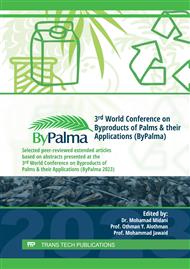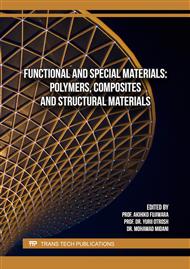[1]
S. Awad, Y. Zhou, E. Katsou, Y. Li, M. Fan, A Critical Review on Date Palm Tree (Phoenix dactylifera L.) Fibres and Their Uses in Bio-composites, Springer Netherlands, 2020.
DOI: 10.1007/s12649-020-01105-2
Google Scholar
[2]
Y. Dong, A. Ghataura, H. Takagi, H.J. Haroosh, A.N. Nakagaito, K.T. Lau, Polylactic acid (PLA) biocomposites reinforced with coir fibres: Evaluation of mechanical performance and multifunctional properties, Compos Part A Appl Sci Manuf 63 (2014) 76–84.
DOI: 10.1016/j.compositesa.2014.04.003
Google Scholar
[3]
R. Siakeng, M. Jawaid, M. Asim, S. Siengchin, Accelerated weathering and soil burial effect on biodegradability, colour and textureof coir/pineapple leaf fibres/PLA biocomposites, Polymers (Basel) 12 (2020).
DOI: 10.3390/polym12020458
Google Scholar
[4]
S. Awad, Y. Zhou, E. Katsou, M. Fan, Polymer Matrix Systems Used for Date Palm Composite Reinforcement, in: M. Midani, N. Saba, O.Y. Alothman (Eds.), Date Palm Fiber Composite, Springer, Singapore, 2020: p.119–159. https://doi.org/.
DOI: 10.1007/978-981-15-9339-0_4
Google Scholar
[5]
S. Awad, T. Hamouda, M. Midani, E. Katsou, M. Fan, Polylactic Acid (PLA) Reinforced with Date Palm Sheath Fiber Bio-Composites: Evaluation of Fiber Density, Geometry, and Content on the Physical and Mechanical Properties, Journal of Natural Fibers 00 (2022) 1–19.
DOI: 10.1080/15440478.2022.2143979
Google Scholar
[6]
T. Alsaeed, B.F. Yousif, H. Ku, The potential of using date palm fibres as reinforcement for polymeric composites, Mater Des 43 (2013) 177–184. https://doi.org/10.1016/j.matdes. 2012.06.061.
DOI: 10.1016/j.matdes.2012.06.061
Google Scholar
[7]
P.J. Herrera-Franco, A. Valadez-González, Mechanical properties of continuous natural fibre-reinforced polymer composites, Compos Part A Appl Sci Manuf 35 (2004) 339–345.
DOI: 10.1016/j.compositesa.2003.09.012
Google Scholar
[8]
M. V. Madurwar, R. V. Ralegaonkar, S.A. Mandavgane, Application of agro-waste for sustainable construction materials: A review, Constr Build Mater 38 (2013) 872–878.
DOI: 10.1016/j.conbuildmat.2012.09.011
Google Scholar
[9]
A. Alawar, A.M. Hamed, K. Al-Kaabi, Characterization of treated date palm tree fiber as composite reinforcement, Compos B Eng 40 (2009) 601–606.
DOI: 10.1016/j.compositesb.2009.04.018
Google Scholar
[10]
L.A. Elseify, M. Midani, L.A. Shihata, H. El-Mously, Review on cellulosic fibers extracted from date palms (Phoenix Dactylifera L.) and their applications, Cellulose 26 (2019) 2209–2232.
DOI: 10.1007/s10570-019-02259-6
Google Scholar
[11]
S. Abani, F. Hafsi, A. Kriker, A. Bali, Valorisation of Date Palm Fibres in Sahara Constructions, in: Energy Procedia, Elsevier Ltd, 2015: p.289–293. https://doi.org/10.1016/ j.egypro.2015.07.608.
DOI: 10.1016/j.egypro.2015.07.608
Google Scholar
[12]
S. Awad, T. Hamouda, M. Midani, Y. Zhou, E. Katsou, M. Fan, Date palm fibre geometry and its effect on the physical and mechanical properties of recycled polyvinyl chloride composite, Ind Crops Prod 174 (2021) 114172.
DOI: 10.1016/j.indcrop.2021.114172
Google Scholar
[13]
O. Benaimeche, A. Carpinteri, M. Mellas, C. Ronchei, D. Scorza, S. Vantadori, The influence of date palm mesh fibre reinforcement on flexural and fracture behaviour of a cement-based mortar, Compos B Eng 152 (2018) 292–299. https://doi.org/10.1016/j.compositesb. 2018.07.017.
DOI: 10.1016/j.compositesb.2018.07.017
Google Scholar
[14]
H. Chaib, A. Kriker, A. Mekhermeche, Thermal Study of Earth Bricks Reinforced by Date palm Fibers, in: Energy Procedia, Elsevier Ltd, 2015: p.919–925. https://doi.org/10.1016/ j.egypro.2015.07.827.
DOI: 10.1016/j.egypro.2015.07.827
Google Scholar
[15]
T. Tioua, A. Kriker, G. Barluenga, I. Palomar, Influence of date palm fiber and shrinkage reducing admixture on self-compacting concrete performance at early age in hot-dry environment, Constr Build Mater 154 (2017) 721–733. https://doi.org/10.1016/j.conbuildmat. 2017.07.229.
DOI: 10.1016/j.conbuildmat.2017.07.229
Google Scholar
[16]
A. Mekhermeche, A. Kriker, S. Dahmani, Contribution to the study of thermal properties of clay bricks reinforced by date palm fiber, in: AIP Conf Proc, American Institute of Physics Inc., 2016.
DOI: 10.1063/1.4959400
Google Scholar
[17]
K. Almi, A. Benchabane, S. Lakel, A. Kriker, Potential utilization of date palm wood as composite reinforcement, Journal of Reinforced Plastics and Composites 34 (2015) 1231–1240.
DOI: 10.1177/0731684415588356
Google Scholar
[18]
A. Mohareb, M.F. Thévenon, E. Wozniak, P. Gérardin, Effects of monoglycerides on leachability and efficacy of boron wood preservatives against decay and termites, Int Biodeterior Biodegradation 64 (2010) 135–138.
DOI: 10.1016/j.ibiod.2009.12.004
Google Scholar
[19]
S.J. Christian, Natural fibre-reinforced noncementitious composites (biocomposites), Elsevier Ltd, 2019.
DOI: 10.1016/B978-0-08-102704-2.00008-1
Google Scholar
[20]
E. Bari, J.J. Morrell, A. Sistani, Durability of natural/synthetic/biomass fiber-based polymeric composites: Laboratory and field tests, Durability and Life Prediction in Biocomposites, Fibre-Reinforced Composites and Hybrid Composites (2018) 15–26.
DOI: 10.1016/B978-0-08-102290-0.00002-7
Google Scholar
[21]
A.S.O. Mohareb, A.H. Hassanin, A.A. Badr, K.T.S. Hassan, R. Farag, Novel composite sandwich structure from green materials: Mechanical, physical, and biological evaluation, J Appl Polym Sci 132 (2015) 4–11.
DOI: 10.1002/app.42253
Google Scholar
[22]
V.A. Alvarez, R.A. Ruseckaite, A. Vázquez, Degradation of sisal fibre/Mater Bi-Y biocomposites buried in soil, Polym Degrad Stab 91 (2006) 3156–3162.
DOI: 10.1016/j.polymdegradstab.2006.07.011
Google Scholar
[23]
Z.N. Azwa, B.F. Yousif, A.C. Manalo, W. Karunasena, A review on the degradability of polymeric composites based on natural fibres, Mater Des 47 (2013) 424–442.
DOI: 10.1016/j.matdes.2012.11.025
Google Scholar



